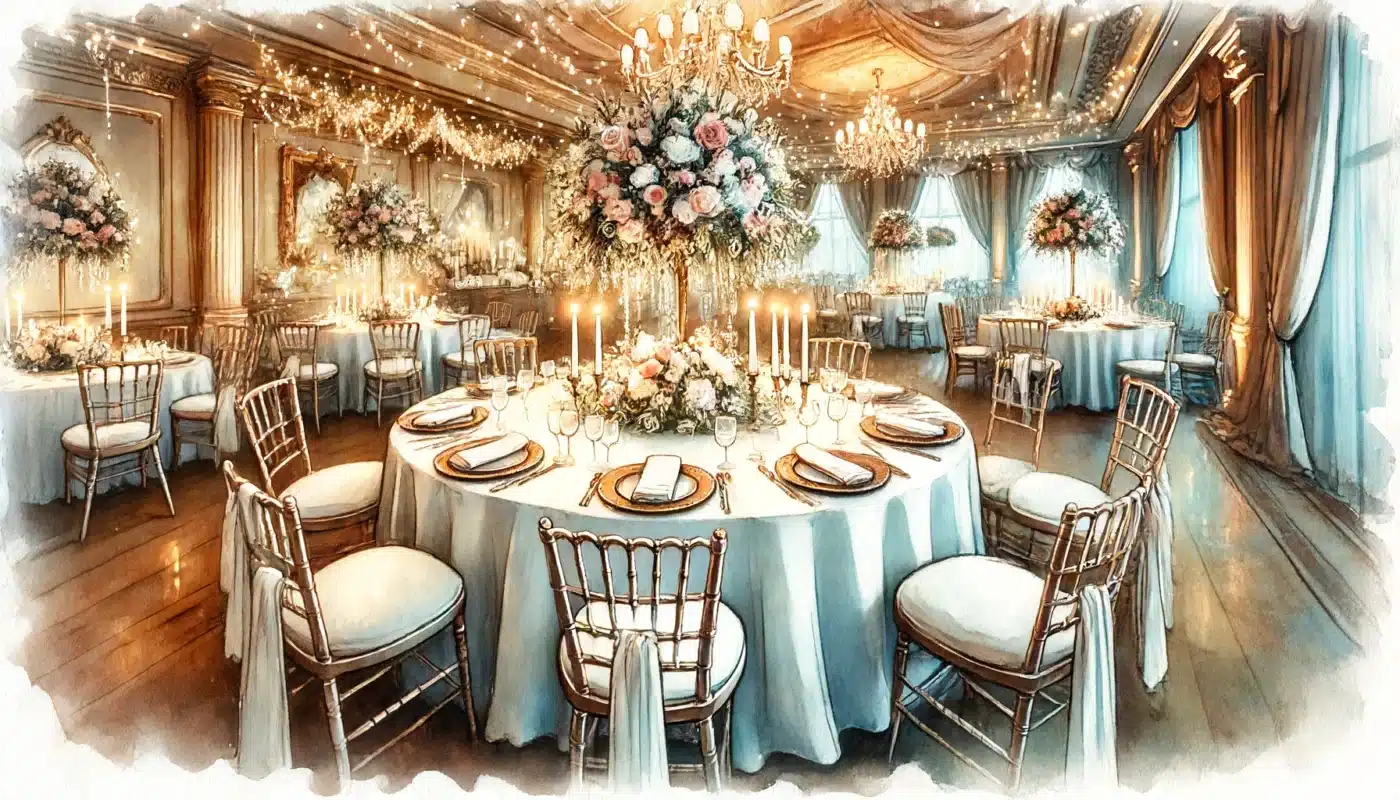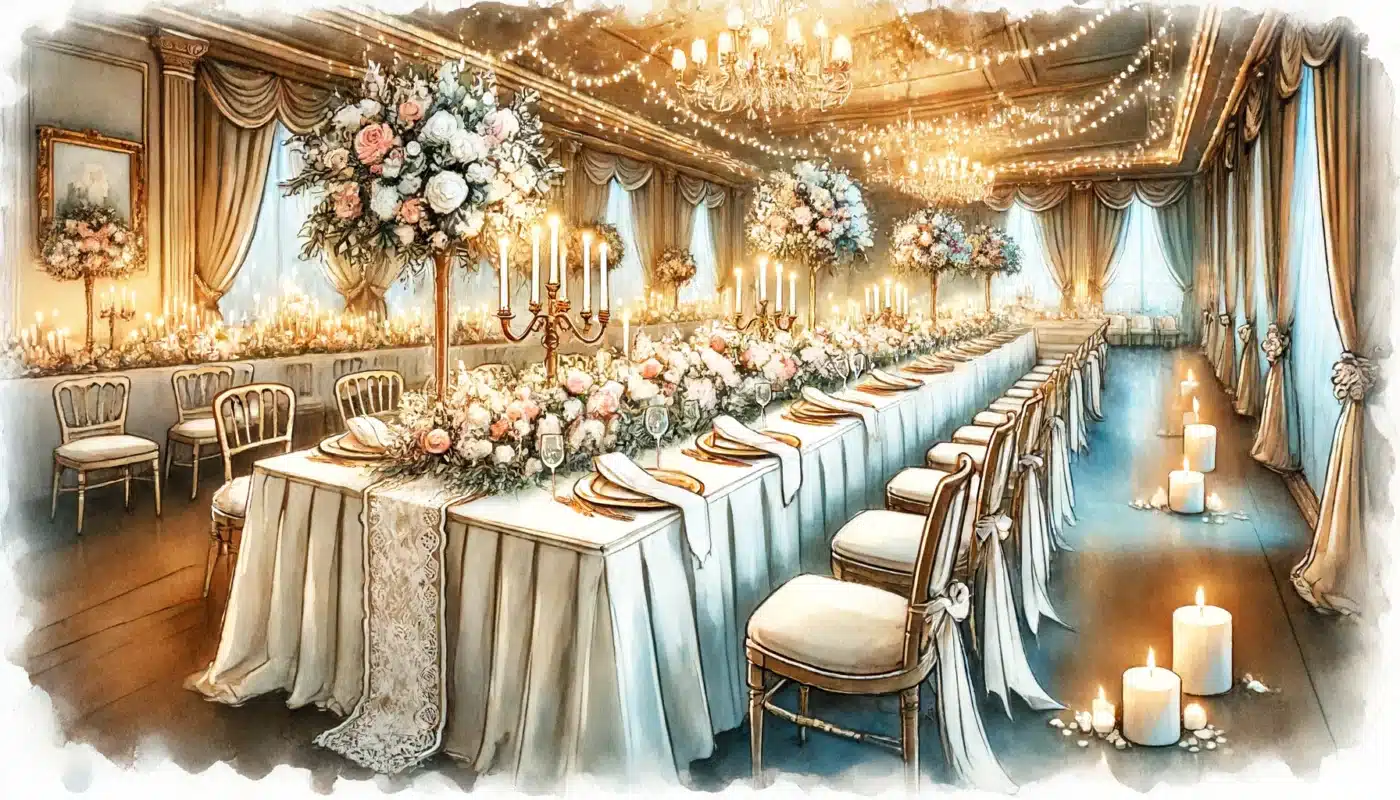A wedding is a celebration of joy, love, traditions, and so much more. Among the many parts of the wedding reception is the top table where select wedding party members and immediate family sit.
wedding top table | wedding table plan ideas
Knowing who traditionally sits at the top table can assist in arranging a smooth and enjoyable celebration.
Traditional Seating Arrangements | traditional top table
The top table typically holds the bride, groom, and their nearest immediate family members and attendants.
The most commonly accepted (traditional top table) setup for a wedding table plan includes:
The Bride and Groom
The married couple usually sits in the center of the top table, for whom the celebration is held.
Parents of the Bride and Groom
- Bride’s Parents: The bride’s mother traditionally sits next to the groom, while the bride’s father sits next to the groom’s mother.
- Groom’s Parents: The groom’s mother is seated next to the bride’s father, and the groom’s father is seated next to the bride.
Best Man and Maid of Honor
- Best Man: The best man traditionally sits next to the bride.
- Maid of Honor: The maid of honor sits next to the groom.
Other Members of the Wedding Party
Depending on the size of the wedding party and the length of the top table, additional members such as the chief bridesmaid, ring bearers, and flower girls might also be included on a traditional top table.

Modern Variations
Although the traditional top table layout works, many modern couples choose variations that best suit their family situations and relationships.
Blended Families | A family table
When couples have blended families, meaning the parents might be divorced and remarried, the arrangement can be modified to include the stepparents. Some options include:
- Arranging a longer top table to include all parental figures.
- Using two top tables, one for the bride’s family and another for the groom’s family.
- Seating only the immediate family and placing stepfamily members at separate tables.
Friend-Centric Arrangements
Couples who are very close with their friends may choose the following top table arrangements:
- Bridesmaids and groomsmen, including the maid of honor and best man.
- Close friends who have significantly supported the couple’s lives.
Sweetheart Table
A popular choice that some couples decide upon is the sweetheart table, in which the bride and groom sit together on their own table. This setup allows the couple to enjoy private conversations while maintaining their focal point in the reception. This choice offers flexibility in that the top table can then be arranged for family and close friends to sit next to each other.
Same-Sex Couples
For same-sex couples, the traditional format can be adapted to reflect their unique relationships and chosen family members. This might include:
- Both brides or both grooms sitting at the center.
- Incorporating close friends or mentors who have played significant roles in their lives.
Wedding Reception Cultural Variations
Cultures may have different wedding seating arrangement traditions. Some examples include:
Indian Weddings
Many Indian weddings have the bride and groom seated on a stage or platform, sometimes with their parents, and the wedding party sits at assigned tables nearby.
Chinese Weddings
Chinese weddings include banquet arrangements that may consist of a head table with the bride, groom, their parents, and possibly grandparents. Family hierarchy is very important.
Western Weddings
In Western weddings, the top table typically includes the bride, groom, maid of honor, best man, and parents. The choice of additional attendees varies by family situation.
Practical Considerations
Practical aspects should be considered when choosing the top table seating arrangement:
Venue Layout
Arrange the top table so that guests have a clear view and the bride and groom are highlighted during speeches and toasts.
Number of Guests in the Wedding Party
Consider a sweetheart table if the wedding will host a large number of guests, so the couple can easily mingle with everyone.
Comfort and Relationships
Ensure all parties feel comfortable with the final arrangement. Avoid conflicts by taking into account family member relationships and dynamics.
Family Politics when choosing a wedding top table
Consider family politics and dynamics, especially when dealing with divorced parents, step parents, or other sensitive relationships. This might mean placing certain family members at a different table to ensure everyone enjoys the day.
Wedding Breakfast and Meal Considerations
The wedding breakfast, or the first meal shared by the newlyweds and their guests, often takes place at the reception venue. The top table arrangement can significantly impact how smoothly the meal proceeds. Consider the following:
Wedding Breakfast
The wedding breakfast is traditionally the first meal enjoyed by the bride and groom after their marriage ceremony. This meal can be a formal sit-down dinner or a more casual buffet. The seating plan for the top table should ensure that the bride and groom can easily interact with all your guests.
Table Layout and Seating Plan
- Round Table: Often used for guests, round tables encourage conversation and provide a clear view of the top table.
- Long Tables: Can be used for both the top table and guest tables, offering a grand and inclusive feel.
- Other Tables: Family tables and party tables should be placed to ensure everyone feels included and has a good view of the head table.
Considerations for Different Wedding Parties
Every wedding party is unique, and the top table should reflect the relationships and dynamics of those involved.
For Same-Sex Couples
Same-sex couples may choose to break tradition and create an arrangement that best reflects their unique relationships. This could mean:
- Having close friends or mentors at the top table.
- Creating a layout that emphasizes equality and inclusiveness.
Involving Close Friends
Modern couples often prioritize the involvement of close friends in their wedding celebrations. This might include:
- Seating close friends who have played significant roles in the couple’s lives at the top table (a party table!).
- Creating a friend-centric arrangement where the bridal party, including the best man and maid of honour, is prominently featured.
Practical Considerations for Table Arrangement
When planning the table seating plan, several practical aspects need to be considered to ensure a seamless wedding day experience.
Table Placement
- Reception Venue Layout: Ensure the top table is placed in a central location with good visibility for all guests.
- Table Placement: Arrange the top table so it does not obstruct the flow of the room or the view of guests.
- Seating Chart or Table Seating Plan: Use a seating chart to organize and communicate the table arrangements to guests.
Comfort and Accessibility
- Ensure that elderly family members and those with special needs are comfortably seated and have easy access to amenities.
- Consider family politics and dynamics, especially with divorced parents and step parents, to avoid potential conflicts.
Breaking Tradition
Modern couples often choose to break tradition to create a wedding day that feels uniquely their own.
Forgoing Family Altogether
Some couples may decide to forgo family altogether at the top table and instead opt for a sweetheart table, where just the newlyweds sit.
Separate Table for Speech Givers
In some cases, it might be practical to have a separate table for those giving speeches, ensuring they can easily access the microphone and podium without disrupting the flow of the meal.
Wedding Top Table | Conclusion
Who sits at the top table at a wedding is an important decision that can dictate the overall reception mood.
From traditional to modern or cultural arrangements, the most important consideration is that honored guests who represent the couple’s inner circle are given appropriate recognition and included in the arrangements.
For more wedding planning tips and to hire a professional wedding violinist to make your special day even more beautiful, see more on our website.



